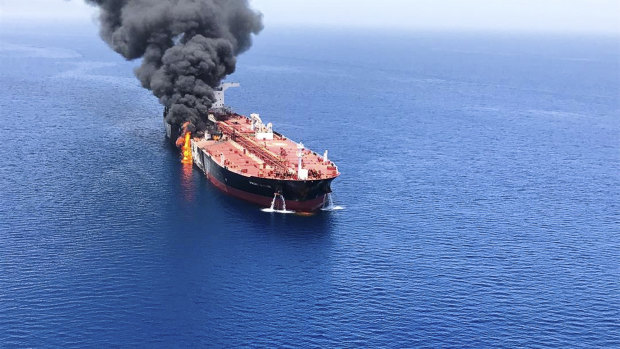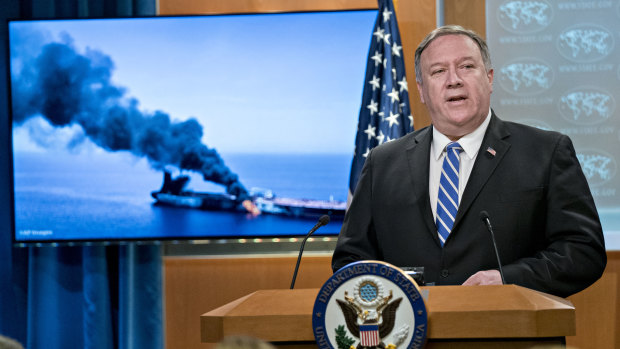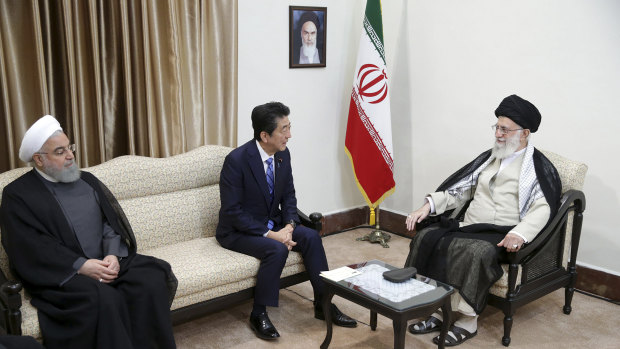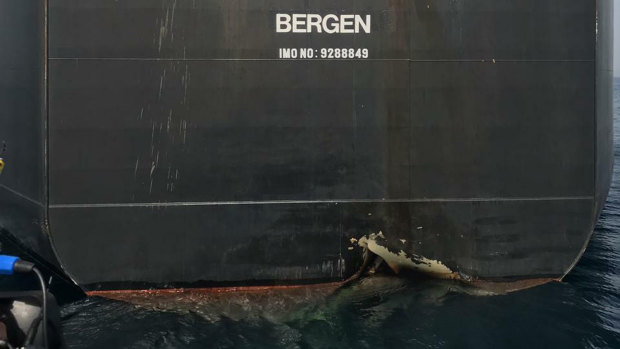This was published 5 years ago
'Attacks' on oil tankers stoke worries about US-Iran conflict
By Nabih Bulos
Beirut: Japanese Prime Minister Shinzo Abe went to Iran this week for a two-day trip that was aimed at cooling tensions in the region. And then things blew up.
On Thursday, two oil tankers – one a Japanese-owned ship – came under suspected attack in the Gulf of Oman. The incident compounded the already simmering hostilities in what’s possibly the world’s most pivotal maritime corridor.

An oil tanker is on fire in the sea of Oman.Credit: AP
US Secretary of State Michael Pompeo quickly blamed Tehran for what he called ‘‘a blatant assault’’ and cited the action as the ‘‘terror, bloodshed and extortion’’ that he says is part of Iranian strategy.
Shortly after, the US military released a video it said showed Iran’s Revolutionary Guard removing an unexploded mine from the side of one of tankers, as well as a photograph showing the apparent mine before its removal.
But the Japanese ship operator said sailors on board its ship, the Kokuka Courageous, saw ‘‘flying objects’’ just before the attack, suggesting the tanker wasn’t damaged by mines and contradicting the US milliary.
The apparent attacks, a month after four other tankers were damaged in mine explosions that the Trump administration also blamed on Iran - without providing evidence - sharply raised fears in the strategically important region that Washington might use such incidents to punish the Islamic Republic even without ironclad proof of its involvement.
Pompeo told reporters in Washington that the assessment was based on US intelligence, the type of weapons used, the level of expertise needed to carry out such attack and that none of Iran's proxy groups, which operate in countries across the region, had the resources to carry out an apparent attack like Thursday's.
"These attacks are a threat to international peace and security, a blatant assault on the freedom of navigation, and an unacceptable escalation of tension by Iran," Pompeo said.
He did not elaborate, offer details or take questions in his brief appearance before reporters at the US State Department.

Mike Pompeo, US Secretary of State, speaks during a press briefing at the State Department in Washington, DC.Credit: Bloomberg
Dozens of crew members were rescued after explosions on the Kokuka Courageous and the Norwegian Front Altair. Iran has denied any connection with the incident.
The suspected attack on a Japanese-owned vessel came as Japanese Prime Minister Shinzo Abe made a rare conciliatory visit to Tehran seeking dialogue.

Japanese Prime Minister Shinzo Abe, centre, meets with Iran's Supreme Leader Ayatollah Ali Khamenei in Tehran on Thursday. Iranian President Hassan Rouhani is at left.Credit: AP
The United States and its Persian Gulf allies, led by Saudi Arabia, have mounted a steady campaign of diplomatic isolation and economic punishment of Iran, which they blame for militancy in the Middle East.
After a closed-door meeting of the UN Security Council overnight Iran dismissed the US envoy's calls for it to meet the Trump administration with diplomacy - "not with terror, attacks on ships, infrastructure and diplomatic facilities" as "another Iranophobic campaign".
The UN secretary-general, Antonio Guterres said "I strongly condemn any attack against civilian vessels. Facts must be established, and responsibilities clarified.
"If there is something the world cannot afford, it is a major confrontation in the Gulf region," Guterres said.
Ahmed Aboul Gheit, the Arab League's secretary-general, warned there were sides seeking to "inflame the region, and practise a kind of dangerous blackmail of the international community."
If there is something the world cannot afford, it is a major confrontation in the Gulf region.
Antonio Guterres, UN secretary-general
The Egyptian also called upon the UN Security Council to confront whoever was behind the suspected attack so the perpetrator could face "all legal responsibility".
What happened?
On Thursday morning, Oman time, the Front Altair and the Kokuka Courageous were sailing in international waters in the Gulf of Oman when they suffered apparent attacks about 40 kilometres off the southern coast of Iran that led to explosions on board.
The Front Altair reported three detonations, according to a statement from the Norwegian Maritime Authority. It was not clear what caused the blasts, but they were serious enough to cause a major fire.
Images depicted the Front Altair engulfed in a 15-mile plume of smoke that was captured by NASA satellites; later pictures showed more than a third of the deck scorched, and a video showed a raging fire in the ship's centre.
The crews - 23 on the Front Altair and 21 on the Kokuka Courageous - were forced to abandon their ships, but had been evacuated and were safe, according to statements by the vessels' owners.
The US Navy, according to a statement released by US Central Command, had rescued the 21 mariners from the Japanese vessel.
Iran earlier had said that it had rescued all 44 of the ships' crew members.

US Central Command released this image it says shows damage and a suspected mine on the Kokuka Courageous in the Gulf of Oman near the coast of Iran. Credit: AP
Sailors abroad the Bainbridge, the US Navy destroyer that went to assist the Kokuka Courageous, saw a device that appeared to be an unexploded mine above the waterline on the hull of the tanker and photographed it, a US official said.
After the captain of the Kokuka Courageous was alerted to the device, he ordered the crew to abandon the damaged ship, a US official said.
Possible use of naval mines to attack the tankers was one piece of information that led US intelligence agencies to reach a preliminary conclusion that Iran's Islamic Revolutionary Guard Corps was responsible for the alleged attacks, one of the officials said.
Last month, Trump administration officials blamed Iran for suspected attacks that damaged four oil tankers off the United Arab Emirates, citing undisclosed evidence that the Revolutionary Guard carried out the attacks using "limpet mines," a naval munition attached to a target by magnets.

The damaged Norwegian-flagged oil tanker MT Andrea Victory off the coast of Fujairah, UAE, last month.Credit: UAE/AP
US National Security Adviser John Bolton has promised to provide evidence to the Security Council proving Iran's culpability in that incident, but has yet to do so.
Regardless of who was behind Thursday's suspected attacks, they triggered a 4.5 per cent increase in world oil prices.
The explosions occurred near the Strait of Hormuz, which serves as a crucial passageway for much of the oil from Gulf states. At its narrowest it measures a mere 21 nautical miles, yet in 2016 it ushered through some 18.5 million barrels of oil per day, according to the US Energy Information Administration.
Those numbers make it an important choke point; any conflict there would have a staggering effect on trade.
While details of Thursday's suspected attacks were not clear, said the Norwegian Maritime Authority, it urged Norwegian ships to "exercise extreme caution in the region" and to "keep a safe distance from Iranian waters." It also raised its security level in the area.
Also unclear was what Iran would gain from such an assault - coinciding with Abe's high-profile visit to Tehran aimed at salvaging the 2015 international nuclear deal.
Both ships, according to the Japanese government, were carrying "Japan-related" cargo, leading Iranian Foreign Minister Javad Zarif to question the timing of the apparent attacks.
"Reported attacks on Japan-related tankers occurred while PM Shinzo Abe was meeting Ayatollah Khamenei for extensive and friendly talks.
"Suspicious," he tweeted, "doesn't begin to describe what likely transpired this morning."
Meanwhile, Abe had brought a message from US President Donald Trump to Ayatollah Khamenei, Iran's supreme leader.
Khamenei rejected the letter, saying Iran had "no trust" in the US and that it would "not repeat the bitter experience" of negotiations, in a reference to the 2015 nuclear deal that was repudiated by Trump.
Khamenei also said he considered Trump an unworthy person with whom to strike up a correspondence.
"I do not have and will not have any response for him," said Khamenei.
Nevertheless, he again emphasised Iran was not seeking the development or use of nuclear weapons.
The Trump administration's quick public assertion of blame concerned some senior US officers, who said they feared that the administration was moving too quickly toward retaliating, possibly with military force, without building a public case that Tehran was responsible.
Another option for the US short of military action would be to seek to build international support for steps to safeguard shipping traffic, using naval ships from the US and other countries to escort tankers and other vessels through the Persian Gulf and into the Arabian Sea.
Pentagon officials said they were worried that Iran and its proxies could conduct its own reprisals against US forces or allies in the region if Washington escalates the confrontation.
"We will defend our interests, but a war with Iran is not in our strategic interest, nor in the best interest of the international community," said Army Lieutenant Colonel Earl Brown, a spokesman for US Central Command, which oversees military operations in the Middle East.
The Pentagon, nevertheless, has substantially increased its forces in the region recently.
Early last month, the aircraft carrier Abraham Lincoln and its strike group of ships arrived in waters near the Persian Gulf in response to what US officials said was intelligence suggesting Iran was preparing attacks.
In late May, a fighter squadron, manned and unmanned reconnaissance aircraft, engineering units and additional Patriot anti-missile batteries - comprising 1500 troops altogether - were added. An amphibious assault ship with a Marine expeditionary unit and an Air Force B-52 bomber task force were also sent.
Another amphibious assault ship, the Arlington, with Marines aboard, arrived in the Arabian Sea this week.
Those forces are in addition to the more than 30,000 troops stationed in the region, along with hundreds of fighters and bombers at air bases in Persian Gulf countries.
Critics warned that Trump administration reliance on military pressure, sanctions and other tactics against Iran carried risks.
"If Iran is behind these attacks, it clearly shows that a US policy relying solely on coercion can backfire," Ali Vaez, senior Iran analyst and Iran project director for the International Crisis Group, said in a statement. "Diplomatic efforts by allies are necessary to dial down the tension, but they can't resolve it as long as Washington relies on an all-or-nothing approach."
LA Times